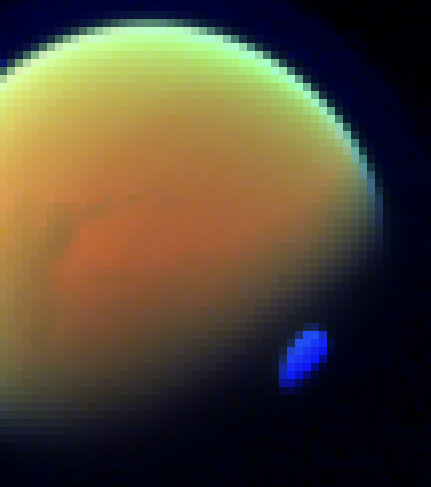Since 2012, an enormous cloud is floating high above the South Pole of Titan, a large moon of Saturn. Astronomers have now discovered that this cloud consists of extremely toxic hydrogen cyanide ice. The ice has probably formed after a rapid cooling of the atmosphere. The results have this week been published in Nature.

Titan is the second largest moon of the solar system and the only one with a thick atmosphere. A year on Titan lasts 29 times as long as on Earth and since 2009 Titan’s southern hemisphere is heading towards winter. Since 2012, a mysterious cloud was visible above Titan’s South Pole in image from the Cassini satellite, which is currently orbiting Saturn and regularly passes Titan at a close distance. Remco de Kok (Leiden University, SRON Netherlands Institute for Space Research), who led the research team: “The appearance of this cloud was a great mystery and no one knew what this cloud was made out of. To determine the composition of this cloud we studied infrared spectra taken by Cassini. In these spectra we found, to our great surprise, at very specific wavelengths the unique fingerprint of hydrogen cyanide ice.”
In Titan’s atmosphere many chemical reactions take place under the influence of sunlight, which convert the present nitrogen and methane gas into other gases, of which the very toxic hydrogen cyanide (or prussic acid) “The fact that this cloud is composed of hydrogen cyanide is completely unexpected,” co-author Nick Teanby (University of Bristol) says. “Hydrogen cyanide only starts to form clouds at extremely low temperatures. At the great altitudes where the cloud is visible (roughly 300 km) we had measured relatively high temperatures only a few months before. The atmosphere there must have cooled about 50 degrees, to a temperature of -150 C, in a very short time.”
Rapid cooling

“This rapid cooling is probably caused by a high concentration of gases, such as HCN and C2H2,” says Remco de Kok. These gases emit a lot of heat in the form of infrared radiation, while the south pole receives only little heat from the Sun during the polar winter. Till the end of the Cassini mission in 2017 there will be new measurements that can measure the temperature and gas concentrations at the place where we see the cloud. These will confirm or reject this hypothesis. “It is not clear whether the cloud will remain visible in the coming years. We already see the cloud changing. This will be an interesting time to see what will happen.”
Publication
The paper HCN ice in Titan’s high-altitude southern polar cloud has this week been published in Nature. The authors are Remco de Kok (Leiden University, SRON Netherlands Institute for Space Research), Nick Teanby (University of Bristol), Luca Maltagliati and Sandrine Vinatier (both University Paris-Diderot), Patrick G. J. Irwin (University of Oxford).
Remco de Kok likes to thank the PEPSci program of the Netherlands Organisation for Scientific Research (NWO). Nick Teanby and Patrick Irwin thank the UK Science and Technology Facilities Council. Luca Maltagliati thanks the Agence Nationale de la Recherche (ANR Project”APOSTIC” no11BS56002, 968 France).


